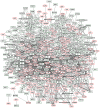Bioinformatics-based study to detect chemical compounds that show potential as treatments for pulmonary thromboembolism
- PMID: 30431066
- PMCID: PMC6257851
- DOI: 10.3892/ijmm.2018.3987
Bioinformatics-based study to detect chemical compounds that show potential as treatments for pulmonary thromboembolism
Abstract
The objectives of the present study comprised the recognition of major genes related to pulmonary thromboembolism (PTE) and the evaluation of their functional enrichment levels, in addition to the identification of small chemical molecules that may offer potential for use in PTE treatment. The RNA expression profiling of GSE84738 was obtained from the Gene Expression Omnibus database. Following data preprocessing, the differently expressed genes (DEGs) between the PTE group and the control group were identified using the Linear Models for Microarray package. Subsequently, the protein‑protein interaction (PPI) network of these DEGs was examined using the Search Tool for the Retrieval of Interacting Genes/Proteins database, visualized via Cytoscape. The most significantly clustered modules in the network were identified using Multi Contrast Delayed Enhancement, a plugin of Cytoscape. Subsequently, functional enrichment analysis of the DEGs was performed, using the Database for Annotation Visualization and Integrated Discovery tool. Furthermore, the chemical‑target interaction networks were investigated using the Comparative Toxicogenomics Database as visualized via Cytoscape. A total of 548 DEGs (262 upregulated and 286 downregulated) were identified in the PTE group, compared with the control group. The upregulated and downregulated genes were enriched in Gene Ontology terms related to inflammation and eye sarcolemma, respectively. Tumor necrosis factor (TNF) and erb‑b2 receptor tyrosine kinase 2 (ERBB2) were upregulated genes that ranked higher in the PPI network (47 and 40 degrees, respectively) whereas C‑JUN was the most downregulated gene (46). Small chemical molecules ethinyl (135), cyclosporine (126), thrombomodulin precursor (113) and tretinoin (111) had >100 degrees in the DEG‑chemical interaction network. In addition, ethinyl targeted to TNF, whereas TNF and ERBB2 were targeted by cyclosporine, and tretinoin was a targeted chemical of ERBB2. Therefore, cyclosporine, ethinyl, and tretinoin may be potential targets for PTE treatment.
Figures





Similar articles
-
Analysis of the protein-protein interaction networks of differentially expressed genes in pulmonary embolism.Mol Med Rep. 2015 Apr;11(4):2527-33. doi: 10.3892/mmr.2014.3006. Epub 2014 Nov 26. Mol Med Rep. 2015. PMID: 25434468 Free PMC article.
-
Identification of candidate target genes of pituitary adenomas based on the DNA microarray.Mol Med Rep. 2016 Mar;13(3):2182-6. doi: 10.3892/mmr.2016.4785. Epub 2016 Jan 14. Mol Med Rep. 2016. PMID: 26782791
-
Exploring the molecular mechanisms of osteosarcoma by the integrated analysis of mRNAs and miRNA microarrays.Int J Mol Med. 2018 Jul;42(1):21-30. doi: 10.3892/ijmm.2018.3594. Epub 2018 Mar 27. Int J Mol Med. 2018. PMID: 29620143 Free PMC article.
-
Identification of key genes and associated pathways in KIT/PDGFRA wild‑type gastrointestinal stromal tumors through bioinformatics analysis.Mol Med Rep. 2018 Nov;18(5):4499-4515. doi: 10.3892/mmr.2018.9457. Epub 2018 Sep 5. Mol Med Rep. 2018. PMID: 30221743 Free PMC article.
-
Identification of critical genes in nucleus pulposus cells isolated from degenerated intervertebral discs using bioinformatics analysis.Mol Med Rep. 2017 Jul;16(1):553-564. doi: 10.3892/mmr.2017.6662. Epub 2017 May 31. Mol Med Rep. 2017. PMID: 28586059 Free PMC article.
Cited by
-
Lateral rectus muscle differentiation potential in paralytic esotropia patients.BMC Ophthalmol. 2021 May 27;21(1):235. doi: 10.1186/s12886-021-01994-4. BMC Ophthalmol. 2021. PMID: 34044792 Free PMC article.
-
Construction and validation of risk prediction models for pulmonary embolism in hospitalized patients based on different machine learning methods.Front Cardiovasc Med. 2024 Jun 25;11:1308017. doi: 10.3389/fcvm.2024.1308017. eCollection 2024. Front Cardiovasc Med. 2024. PMID: 38984357 Free PMC article.
-
Integrated bioinformatics analysis of core regulatory elements involved in keloid formation.BMC Med Genomics. 2021 Oct 2;14(1):239. doi: 10.1186/s12920-021-01087-7. BMC Med Genomics. 2021. PMID: 34600545 Free PMC article.
-
Clinical Characteristics of Patients with Pulmonary Thromboembolism Based on Computer Statistical Analysis.J Healthc Eng. 2022 Feb 22;2022:1112960. doi: 10.1155/2022/1112960. eCollection 2022. J Healthc Eng. 2022. Retraction in: J Healthc Eng. 2023 Jan 22;2023:9827194. doi: 10.1155/2023/9827194. PMID: 35242294 Free PMC article. Retracted.
References
-
- Santhakumar R, Ramalingam PK, Gayathri K, Manjunath BV, Karuppusamy N, Vetriveeran B, Selvamani S, Vishnuram P, Natarajan K. Pulmonary thromboembolism presenting as multiple pulmonary cavities. J Assoc Physicians India. 2016;64:85–86. - PubMed
-
- Kostadima E, Zakynthinos E. Pulmonary embolism: Pathophysiology, diagnosis, treatment. Hellenic J Cardiol. 2007;48:94–107. - PubMed
-
- Yılmaz M. Evaluation of Tp‑e interval, Tp‑e/qt ratio and Tp‑e/Qtc ratio in patients with acute pulmonary thromboembolism. Am J Cardiol. 2018;121:e19. doi: 10.1016/j.amjcard.2018.03.066. - DOI
MeSH terms
Substances
LinkOut - more resources
Full Text Sources
Medical
Research Materials
Miscellaneous

